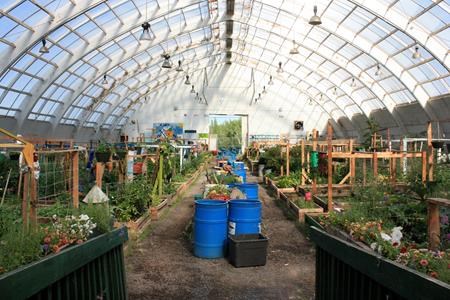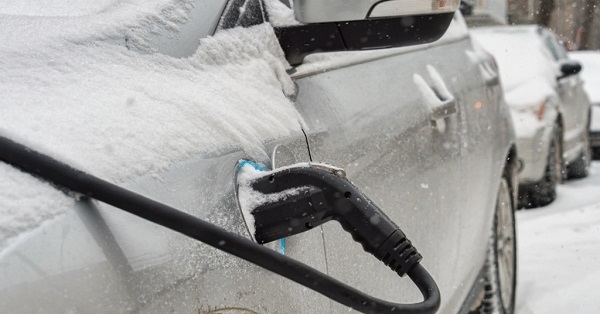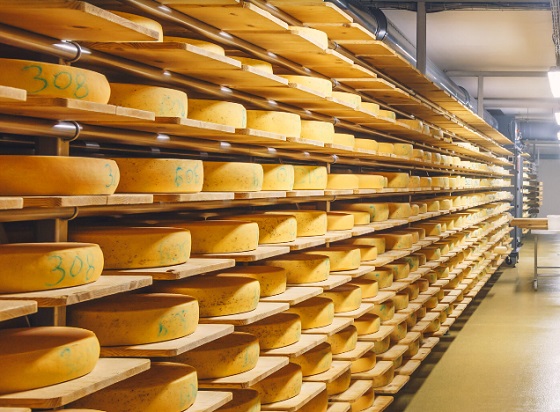Alberta
Greenhouses aim to bring fresh produce to North, putting a dent in food insecurity

INUVIK, N.W.T. — Rows upon rows of raised beds growing tomatoes, zucchini, beans, wildflowers and herbs line the inside of the Inuvik Community Greenhouse.
Sunlight streams through the panes of the curved ceiling above as children sprinkle their crop with green plastic watering cans.
The commercial greenhouse in the western Arctic community in the Northwest Territories is in a former hockey arena. There, community members can rent plots to grow vegetables and other plants, and learn about gardening.
“Every time I come in here, I only ever see people smiling,” said Adi Scott, who co-ordinates the greenhouse.
Remote and Indigenous communities, particularly in the North, are increasingly using greenhouses to grow their own produce, promote self-sufficiency and in some cases create economic opportunity, said Andrew Spring, an assistant professor at Wilfrid Laurier University and a Canada Research Chair in northern sustainable food systems.
“Food security has been an issue across the North because of the high cost of groceries … (and) the long-term impacts of colonization on northern Indigenous communities,” Spring said.
Data from Statistics Canada indicates that 46.1 per cent of people in Nunavut, 23.1 per cent in the Northwest Territories and 15.3 per cent in the Yukon lived in food-insecure households in 2019 compared with a national average of 10.6 per cent.
Much of the food flown North is processed, not to mention expensive, and access to fresh fruits or vegetables is limited, said Spring. Meanwhile, participation in traditional activities like gathering or hunting have been declining for decades in many communities, meaning they rely more on food from stores, he said.
Climate change “makes a vulnerable situation even more precarious,” said Spring, as it causes disruptions in air travel or on long-used ice roads.
Scott said the Inuvik greenhouse, which runs from April to September, can help put a dent in the grocery bill, but isn’t enough to truly reduce reliance on food from outside the territory. Instead, the greenhouse’s main focus is on education and community-building.
These days, it’s not difficult to get the funds to start up a greenhouse in a remote community, said Spring, with lots of federal programs available for agriculture and climate adaptation.
In December 2022, the federal government announced $19.5 million in support for up to 79 new projects across the country related to food security in Indigenous, remote and Northern communities as part of the fourth phase of the Local Food Infrastructure Fund. Since 2019, it has supported around 900 projects across the country, including greenhouses in remote and northern communities.
It’s important that organizations helping to start up greenhouse and other agriculture projects work with the community, said Raygan Solotki, executive director of Green Iglu. The non-profit helps remote communities plan, build and run projects, specializing in geodesic dome greenhouses.
“We’re not coming in on a horse, riding in with a greenhouse,” said Solotki. “We’re here to work with the community to make sure we are doing what the community wants.”
The biggest challenges often come once the greenhouse has been built, Spring said. Some communities have had more success than others building a sustainable long-term greenhouse or garden project, and it often revolves around having one person or a small group of people willing to commit to running it, he said.
“This community champion, who is passionate about it, and who has the kind of skills and the knowledge to do the work. And having those people stay in the community is often the challenge.”
Tom Henheffer, co-chief executive officer of the Arctic Research Foundation, also stressed the importance of building relationships with communities for projects to be successful.
The foundation partnered with Agriculture and Agri-Food Canada, National Research Council Canada, the Canadian Space Agency and the community of Gjoa Haven, Nvt., on the Naurvik project, a community-led hydroponic food system that started in 2019.
“A number of similar projects have failed and what differentiates this is really the people building it from the ground up with the community,” Henheffer said.
The work in the greenhouse is done by local technicians and its location was chosen by elders, Henheffer said. He added community members know best which vegetables local people want to eat to pair with foods like caribou stew and Arctic char.
Betty Kogvik, one of the technicians at the greenhouse, said it’s important for the community.
“The cost of food or produce we get from the store is really high … and when we finally receive them, some are already mouldy.”
Kogvik said high food costs are especially challenging for elders and people reliant on social assistance. She’s proud that everything grown at the greenhouse goes to elders and children.
The main food sources in the community are hunting and fishing, Kogvik said, and people share what they have harvested with friends and family.
Kogvik said she’d like to see the greenhouse project extended to other communities, adding it also provides employment opportunities.
The Naurvik project’s system is made from three retrofitted shipping containers and primarily uses wind and solar power year-round. Many northern communities are reliant on diesel, which can be costly and produce harmful emissions.
Conditions in Gjoa Haven, about 250 kilometres north of the Arctic Circle, make it difficult to grow vegetables. Access to fresh produce in the community is limited and expensive, Henheffer said, with vegetables nearing expiration by the time they reach shelves.
He said part of the project aims to replicate the system in other communities to increase access to fresh produce. The Canadian Space Agency is also interested in the technology to potentially grow food in space.
Hydroponics is a higher-tech way of indoor growing that doesn’t use soil, and is often used to grow herbs and leafy greens. Spring noted that in order to truly make a dent in food insecurity, northern growing projects need to be able to produce heartier vegetables that can be stored — “things that go in stew” as opposed to “salad.” Because of this, he said he’s wary of high-tech solutions like hydroponics.
But it all depends on what the community is looking for, he said, whether that’s a commercially viable greenhouse or a place to grow salad as an addition to the food available.
“Anything helps,” he said.
But the key to putting a dent in the food insecurity problem is “doing agriculture in a way that actually is the side dish to the traditional food system.”
This report by The Canadian Press was first published June 21, 2023.
— With files from Rosa Saba in Toronto
Emily Blake, The Canadian Press
Alberta
Alberta project would be “the biggest carbon capture and storage project in the world”

Pathways Alliance CEO Kendall Dilling is interviewed at the World Petroleum Congress in Calgary, Monday, Sept. 18, 2023.THE CANADIAN PRESS/Jeff McIntosh
From Resource Works
Carbon capture gives biggest bang for carbon tax buck CCS much cheaper than fuel switching: report
Canada’s climate change strategy is now joined at the hip to a pipeline. Two pipelines, actually — one for oil, one for carbon dioxide.
The MOU signed between Ottawa and Alberta two weeks ago ties a new oil pipeline to the Pathways Alliance, which includes what has been billed as the largest carbon capture proposal in the world.
One cannot proceed without the other. It’s quite possible neither will proceed.
The timing for multi-billion dollar carbon capture projects in general may be off, given the retreat we are now seeing from industry and government on decarbonization, especially in the U.S., our biggest energy customer and competitor.
But if the public, industry and our governments still think getting Canada’s GHG emissions down is a priority, decarbonizing Alberta oil, gas and heavy industry through CCS promises to be the most cost-effective technology approach.
New modelling by Clean Prosperity, a climate policy organization, finds large-scale carbon capture gets the biggest bang for the carbon tax buck.
Which makes sense. If oil and gas production in Alberta is Canada’s single largest emitter of CO2 and methane, it stands to reason that methane abatement and sequestering CO2 from oil and gas production is where the biggest gains are to be had.
A number of CCS projects are already in operation in Alberta, including Shell’s Quest project, which captures about 1 million tonnes of CO2 annually from the Scotford upgrader.
What is CO2 worth?
Clean Prosperity estimates industrial carbon pricing of $130 to $150 per tonne in Alberta and CCS could result in $90 billion in investment and 70 megatons (MT) annually of GHG abatement or sequestration. The lion’s share of that would come from CCS.
To put that in perspective, 70 MT is 10% of Canada’s total GHG emissions (694 MT).
The report cautions that these estimates are “hypothetical” and gives no timelines.
All of the main policy tools recommended by Clean Prosperity to achieve these GHG reductions are contained in the Ottawa-Alberta MOU.
One important policy in the MOU includes enhanced oil recovery (EOR), in which CO2 is injected into older conventional oil wells to increase output. While this increases oil production, it also sequesters large amounts of CO2.
Under Trudeau era policies, EOR was excluded from federal CCS tax credits. The MOU extends credits and other incentives to EOR, which improves the value proposition for carbon capture.
Under the MOU, Alberta agrees to raise its industrial carbon pricing from the current $95 per tonne to a minimum of $130 per tonne under its TIER system (Technology Innovation and Emission Reduction).
The biggest bang for the buck
Using a price of $130 to $150 per tonne, Clean Prosperity looked at two main pathways to GHG reductions: fuel switching in the power sector and CCS.
Fuel switching would involve replacing natural gas power generation with renewables, nuclear power, renewable natural gas or hydrogen.
“We calculated that fuel switching is more expensive,” Brendan Frank, director of policy and strategy for Clean Prosperity, told me.
Achieving the same GHG reductions through fuel switching would require industrial carbon prices of $300 to $1,000 per tonne, Frank said.
Clean Prosperity looked at five big sectoral emitters: oil and gas extraction, chemical manufacturing, pipeline transportation, petroleum refining, and cement manufacturing.
“We find that CCUS represents the largest opportunity for meaningful, cost-effective emissions reductions across five sectors,” the report states.

Fuel switching requires higher carbon prices than CCUS.
Measures like energy efficiency and methane abatement are included in Clean Prosperity’s calculations, but again CCS takes the biggest bite out of Alberta’s GHGs.
“Efficiency and (methane) abatement are a portion of it, but it’s a fairly small slice,” Frank said. “The overwhelming majority of it is in carbon capture.”

From left, Alberta Minister of Energy Marg McCuaig-Boyd, Shell Canada President Lorraine Mitchelmore, CEO of Royal Dutch Shell Ben van Beurden, Marathon Oil Executive Brian Maynard, Shell ER Manager, Stephen Velthuizen, and British High Commissioner to Canada Howard Drake open the valve to the Quest carbon capture and storage facility in Fort Saskatchewan Alta, on Friday November 6, 2015. Quest is designed to capture and safely store more than one million tonnes of CO2 each year an equivalent to the emissions from about 250,000 cars. THE CANADIAN PRESS/Jason Franson
Credit where credit is due
Setting an industrial carbon price is one thing. Putting it into effect through a workable carbon credit market is another.
“A high headline price is meaningless without higher credit prices,” the report states.
“TIER credit prices have declined steadily since 2023 and traded below $20 per tonne as of November 2025. With credit prices this low, the $95 per tonne headline price has a negligible effect on investment decisions and carbon markets will not drive CCUS deployment or fuel switching.”
Clean Prosperity recommends a kind of government-backstopped insurance mechanism guaranteeing carbon credit prices, which could otherwise be vulnerable to political and market vagaries.
Specifically, it recommends carbon contracts for difference (CCfD).
“A straight-forward way to think about it is insurance,” Frank explains.
Carbon credit prices are vulnerable to risks, including “stroke-of-pen risks,” in which governments change or cancel price schedules. There are also market risks.
CCfDs are contractual agreements between the private sector and government that guarantees a specific credit value over a specified time period.
“The private actor basically has insurance that the credits they’ll generate, as a result of making whatever low-carbon investment they’re after, will get a certain amount of revenue,” Frank said. “That certainty is enough to, in our view, unlock a lot of these projects.”
From the perspective of Canadian CCS equipment manufacturers like Vancouver’s Svante, there is one policy piece still missing from the MOU: eligibility for the Clean Technology Manufacturing (CTM) Investment tax credit.
“Carbon capture was left out of that,” said Svante co-founder Brett Henkel said.
Svante recently built a major manufacturing plant in Burnaby for its carbon capture filters and machines, with many of its prospective customers expected to be in the U.S.
The $20 billion Pathways project could be a huge boon for Canadian companies like Svante and Calgary’s Entropy. But there is fear Canadian CCS equipment manufacturers could be shut out of the project.
“If the oil sands companies put out for a bid all this equipment that’s needed, it is highly likely that a lot of that equipment is sourced outside of Canada, because the support for Canadian manufacturing is not there,” Henkel said.
Henkel hopes to see CCS manufacturing added to the eligibility for the CTM investment tax credit.
“To really build this eco-system in Canada and to support the Pathways Alliance project, we need that amendment to happen.”
Resource Works News
Alberta
Alberta Next Panel calls for less Ottawa—and it could pay off

From the Fraser Institute
By Tegan Hill
Last Friday, less than a week before Christmas, the Smith government quietly released the final report from its Alberta Next Panel, which assessed Alberta’s role in Canada. Among other things, the panel recommends that the federal government transfer some of its tax revenue to provincial governments so they can assume more control over the delivery of provincial services. Based on Canada’s experience in the 1990s, this plan could deliver real benefits for Albertans and all Canadians.
Federations such as Canada typically work best when governments stick to their constitutional lanes. Indeed, one of the benefits of being a federalist country is that different levels of government assume responsibility for programs they’re best suited to deliver. For example, it’s logical that the federal government handle national defence, while provincial governments are typically best positioned to understand and address the unique health-care and education needs of their citizens.
But there’s currently a mismatch between the share of taxes the provinces collect and the cost of delivering provincial responsibilities (e.g. health care, education, childcare, and social services). As such, Ottawa uses transfers—including the Canada Health Transfer (CHT)—to financially support the provinces in their areas of responsibility. But these funds come with conditions.
Consider health care. To receive CHT payments from Ottawa, provinces must abide by the Canada Health Act, which effectively prevents the provinces from experimenting with new ways of delivering and financing health care—including policies that are successful in other universal health-care countries. Given Canada’s health-care system is one of the developed world’s most expensive universal systems, yet Canadians face some of the longest wait times for physicians and worst access to medical technology (e.g. MRIs) and hospital beds, these restrictions limit badly needed innovation and hurt patients.
To give the provinces more flexibility, the Alberta Next Panel suggests the federal government shift tax points (and transfer GST) to the provinces to better align provincial revenues with provincial responsibilities while eliminating “strings” attached to such federal transfers. In other words, Ottawa would transfer a portion of its tax revenues from the federal income tax and federal sales tax to the provincial government so they have funds to experiment with what works best for their citizens, without conditions on how that money can be used.
According to the Alberta Next Panel poll, at least in Alberta, a majority of citizens support this type of provincial autonomy in delivering provincial programs—and again, it’s paid off before.
In the 1990s, amid a fiscal crisis (greater in scale, but not dissimilar to the one Ottawa faces today), the federal government reduced welfare and social assistance transfers to the provinces while simultaneously removing most of the “strings” attached to these dollars. These reforms allowed the provinces to introduce work incentives, for example, which would have previously triggered a reduction in federal transfers. The change to federal transfers sparked a wave of reforms as the provinces experimented with new ways to improve their welfare programs, and ultimately led to significant innovation that reduced welfare dependency from a high of 3.1 million in 1994 to a low of 1.6 million in 2008, while also reducing government spending on social assistance.
The Smith government’s Alberta Next Panel wants the federal government to transfer some of its tax revenues to the provinces and reduce restrictions on provincial program delivery. As Canada’s experience in the 1990s shows, this could spur real innovation that ultimately improves services for Albertans and all Canadians.
-

 Business1 day ago
Business1 day ago“Magnitude cannot be overstated”: Minnesota aid scam may reach $9 billion
-

 Haultain Research6 hours ago
Haultain Research6 hours agoSweden Fixed What Canada Won’t Even Name
-

 Business1 day ago
Business1 day agoLargest fraud in US history? Independent Journalist visits numerous daycare centres with no children, revealing massive scam
-

 Censorship Industrial Complex1 day ago
Censorship Industrial Complex1 day agoUS Under Secretary of State Slams UK and EU Over Online Speech Regulation, Announces Release of Files on Past Censorship Efforts
-

 Daily Caller2 days ago
Daily Caller2 days agoIs Ukraine Peace Deal Doomed Before Zelenskyy And Trump Even Meet At Mar-A-Lago?
-

 Business6 hours ago
Business6 hours agoWhat Do Loyalty Rewards Programs Cost Us?









